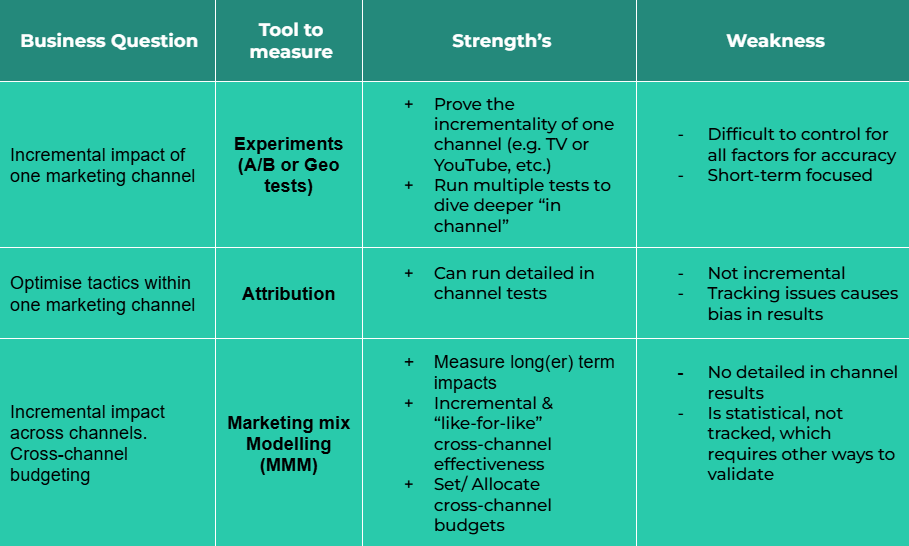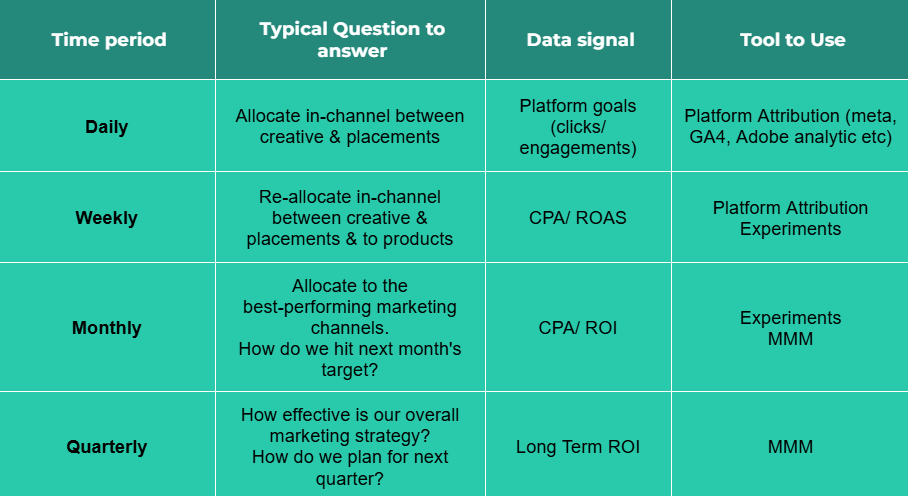The Modern Marketer's Guide: Choosing The Best Marketing Measurement Tools
Getting into more complex marketing measurement starts with some bad news: No single marketing measurement tool will answer all of your questions. To achieve a complete, high-confidence view of your marketing impact, you need a cohesive strategy.
Here at Linea Analytics, we recommend a simple but powerful principle:
Your business question = right tool to measure
This leaves us with three key questions we need to answer to build an effective measurement strategy.
1. What tools do we use to answer which question?
The foundation of your strategy is knowing which tool is best suited for your specific objectives.
Table 1: Mapping questions to marketing measurement tools & the pros/cons of each approach

In our experience, the best long-term measurement plan requires using multiple tools to answer all questions.
However, when starting your journey, which approach is right to start with?
Experiments: Best if running 1 or 2 channels, and you want to understand what's
working
E.g. How much incremental returns is Meta driving?
Attribution: can be used if you want to improve the ROI within a channel.
E.g. How do we
improve Meta ROI?
MMM: Best if running 2+ channels and you want to understand what's working & how to
set the budget
E.g. How do I allocate budget between our marketing channels to hit our target?
Here at Linea, we tailor our measurement solutions to focus on answering your business questions. This moves your measurement tool from focusing on reporting to driving future growth for your brand.
2. When do we make decisions based on each measurement tool?
With each tool supporting a different frequency of change, we map when to make decisions.
Whilst each brand & media agency might slightly differ on the frequency, cadence and data signal used. The following shows Linea’s recommendation for what tactics or strategy to adapt at which time point. This template should be set out in your measurement strategy.
Table 2: When to make changes to your marketing plan?

At Linea, we recognise that historically, MMM has been seen as slow and backwards-looking. That's why we built an Always-on MMM approach. This means we can provide faster delivery, reducing time to action and allowing for incremental, focused measurement at the speed of other measurement approaches.
3. How do you bring different marketing measurement approaches together?
You have followed the best practice: you have multiple measurement tools and are using each at different times. But you still have a problem… the tools are giving different results!
We can overcome this friction in two ways:
-
Focus on the measurement best placed to answer each question
In section 1, we clearly set out which tool is best for measuring different questions. Stick to it.
-
Use each tool tactically to answer a specific question
-
Only use it at the agreed time period/ frequency
-
Agree with wider teams (finance & operations) on which metrics can be shared, fostering a culture where different metrics are accepted for different purposes.
-
Align approaches (double verification)
While the first approach sounds good on paper. When dashboards start showing different numbers, it can cause friction or nervousness.
At this point, you can align the approaches. At Linea, we call this double verification. It involves:
- Calibrating your attribution results with the holistic view from MMM.
- Or, using tests to validate the results of your MMM.
This alignment is essential because it:
- Builds confidence that your measurement is accurate and robust.
- Builds a single, trusted number that can be reported to wider teams & stakeholders.
In summary
It is not true to say that one measurement solution is best placed to answer all your business questions. Brands need to focus on their key questions, and only then can the right combination of marketing measurement tools be selected. A measurement framework that leverages the speed of experiments and the strategic insight of Always-on MMM is the gold standard for driving growth from marketing measurement.
